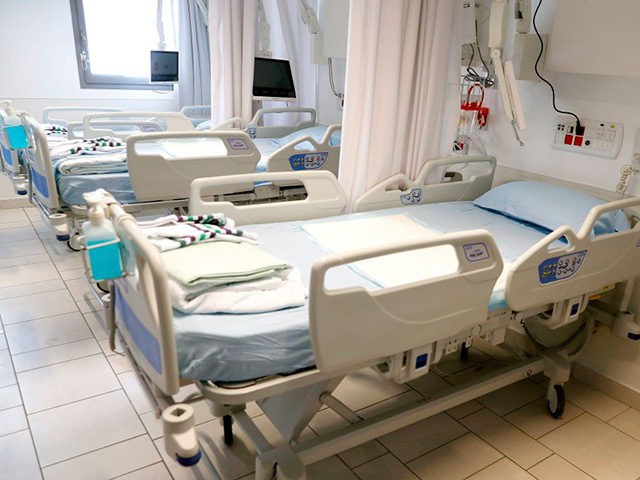The Institute for Health Metrics and Evaluation (IHME) epidemiological model cited recently by the medical experts on the White House Coronavirus Task Force now projects that 37 states do not currently have enough hospital bed capacity to handle the peak number of patients expected to be hospitalized in their states.
Of these 37 states, 22 will have enough regular hospital beds but not enough ICU hospital beds. Fifteen states and the District of Columbia will face shortages of both regular hospital beds and ICU hospital beds.
Thirteen states have enough regular hospital beds as well as ICU hospital beds to handle the peak number of coronavirus patients in their states, the model projects.
Different states will reach their peak number of deaths and hospital admissions at different times over the next 60 days.
The model currently projects that New York, for instance, will reach its peak number of deaths–827 per day–in just nine days, on April 9, with peak resources coming one day earlier on April 8. In contrast, the model projects that Virginia will reach its peak number of deaths–31 per day–almost two months from now, on May 25, with peak resource use coming there on May 28.
The results of the initial study based on the IHME model “used data on confirmed COVID-19 deaths by day from WHO websites and local and national governments; data on hospital capacity and utilization for US states; and observed COVID-19 utilization data from select locations to develop a statistical model forecasting deaths and hospital utilization against capacity by state for the US over the next 4 months,” were first published at Healthdata.org, the IHME website, on March 26:
Compared to licensed capacity and average annual occupancy rates, excess demand from COVID-19 at the peak of the pandemic in the second week of April is predicted to be 64,175 (95% UI 7,977 to 251,059) total beds and 17,309 (95% UI 2,432 to 57,584) ICU beds. At the peak of the pandemic, ventilator use is predicted to be 19,481 (95% UI 9,767 to 39,674). The date of peak excess demand by state varies from the second week of April through May. We estimate that there will be a total of 81,114 deaths (95% UI 38,242 to 162,106) from COVID-19 over the next 4 months in the US. Deaths from COVID-19 are estimated to drop below 10 deaths per day between May 31 and June (emphasis added.)
Subsequent to the publication of the initial results, the IHME model has been updated with the most recent data provided by departments of health in the 50 states and the District of Columbia every 24 hours. “The model was most recently updated at 6 a.m. Pacific, March 31, 2020,” Healthdata.org reported.
The most recent update of the model is slightly more pessimistic than the first results published on March 26. It now projects, as of March 31, that there will be a total of 83,945 deaths from COVID-19 over the next four months. (emphasis added)
According to the updated projections in the IHME model as of Tuesday morning, March 31, these 13 states have sufficient regular hospital bed and ICU hospital bed capacity to handle the anticipated number of coronavirus who will require hospitalization on the peak days in their states:
Alabama, California, Indiana, Kentucky, Mississippi, Missouri, Nebraska, North Dakota, Ohio, Oregon, Pennsylvania, Vermont, and Wyoming.
These 22 states will have sufficient regular hospital bed capacity but insufficient ICU hospital bed capacity, according to the model’s most recent projections:
Arkansas, Alaska, Arizona, Connecticut, Florida, Georgia, Idaho, Illinois, Iowa, Kansas, Minnesota, Nevada, New Mexico, Oklahoma, South Carolina, South Dakota, Texas, Utah, Virginia, Washington, West Virginia, and Wisconsin.
These 15 states and the District of Columbia will not have sufficient regular hospital bed or ICU hospital bed capacity, according to the model’s most recent projections:
Colorado, Delaware, the District of Columbia, Hawaii, Louisiana, Massachusetts, Maryland, Maine, Michigan, Montana, New Hampshire, New Jersey, New York, North Carolina, Rhode Island, and Tennessee.
The IHME model appears to have some volatility within state level projections.
For instance, on March 30, the model projected that Tennessee will experience 1,067 COVID-19 deaths and will have more than enough regular hospital beds and ICU hospital beds to deal with the peak hospital admissions of patients with coronavirus.
However, one day later, on March 31, those projections changed dramatically, projecting that Tennessee will experience 4,985 COVID-19 deaths and will need significantly more regular hospital beds and ICU hospital beds than it currently has to deal with the peak hospital admissions of patients with coronavirus.
The most significant change in the underlying data used in the model is that the number of actual COVID-19 deaths in Tennessee increased by six in one day, from eight on March 29 to 14 on March 30.
Research for the IHME model was headed up by Professor Chris Murray of the University of Washington, the executive director of the IHME. “Funding was provided by the Bill & Melinda Gates Found and the State of Washington,” according to this report on the study published on March 30 at MedRxiv.

COMMENTS
Please let us know if you're having issues with commenting.